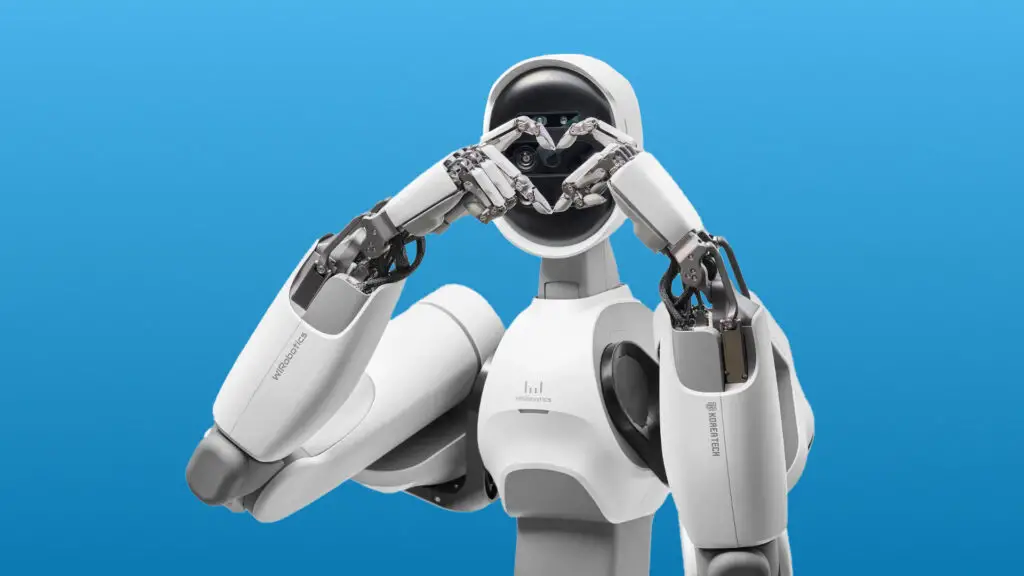Technology has once again taken a leap into the future, as South Korea introduces its groundbreaking all-muscle humanoid robot named ALLEX. Developed by WIRobotics and unveiled at the prestigious Robot Innovation Hub (RIH) at Korea University of Technology.
This humanoid machine is not just another entry into the robotics race it marks a revolutionary step toward robots that can truly move, adapt, and interact like humans.
Unlike traditional robots that rely heavily on rigid mechanical systems, ALLEX is designed with a muscle inspired actuation system. The all-muscle humanoid robot mimics the flexibility, precision, and natural adaptability of human muscles.
This enables it to respond to real world conditions such as force, contact, and impact something most robots struggle to achieve without extensive programming or safety limitations.
According to WIRobotics, ALLEX’s design is rooted in their vision of an ALL EXperience machine a robot capable of understanding and responding not only through sensors but also through nuanced muscle like responses.
Force sensitive actuation ALLEX adapts instantly when encountering resistance, much like a human adjusting grip strength while holding fragile objects. Visual recognition equipped with advanced vision systems, it can identify and navigate through complex environments.
Positional control Its balance and motion are comparable to humans, ensuring safer operation in both industrial and domestic spaces. Multi domain applications from assisting in factories to helping elderly care at home, its flexibility gives it wide usability.
Robotics in Industrial Workspaces
The introduction of ALLEX has been compared to earlier robotic implementations in industrial settings. For instance, Hyundai’s Spot robot developed with Boston Dynamics is used to monitor safety in manufacturing plants. While Spot excels in mobility and surveillance, it lacks the fine motor skills required for delicate, hands on tasks.
ALLEX, however, with its all-muscle humanoid robot design, bridges this gap. In early pilot tests within South Korean factories, workers reported that ALLEX was capable of assisting in tasks such as handling fragile parts, adjusting tools, and even packaging without damaging materials.
One worker described it as like having a human assistant who never gets tired. This highlights how muscle like robotics could change not just automation, but also human robot collaboration in industries where precision and adaptability are crucial.
Dr. Min woo Park, a robotics engineer at the Korea Institute of Advanced Technology, emphasized. The development of an all-muscle humanoid robot represents a paradigm shift.
Instead of robots replacing humans, we are now seeing machines that can work alongside us more naturally, responding in real time to physical interaction.
Similarly, Professor Helen Carter from MIT’s Robotics Lab noted. Robots like ALLEX move us closer to what we call ‘embodied intelligence.’ They don’t just think like humans they begin to feel and respond in a way that mimics biological systems.
This could transform industries from healthcare to space exploration. These perspectives underline how ALLEX is not just a technological marvel, but a potential game changer in how humans perceive and interact with robots.
A Glimpse into Human Robot Interaction
At the unveiling event, journalists and attendees were allowed to test ALLEX’s interaction. One participant shared their experience. When I shook hands with ALLEX, it adjusted its grip naturally. It wasn’t too firm, nor too loose it felt uncannily human.
When I gently pushed against its arm, it resisted just enough, like a person would. That moment changed my perception of robots forever. This personal experience demonstrates the essence of the all-muscle humanoid robot its ability to create interactions that feel real, safe, and human like.
The Future of Muscle Robots
The unveiling of ALLEX raises broader questions about the future of humanoid robotics. Unlike robots designed purely for speed or strength, muscle based robots bring versatility and emotional resonance.
1. Healthcare & Elderly Care Robots that can gently lift, support, or assist without risking harm to fragile patients.
2. Domestic Assistance from cooking to cleaning, ALLEX can handle tasks with precision.
3. Education & companionship children and elderly individuals could interact more naturally with robots that move and respond like humans.
4. Space exploration astronauts may benefit from robotic counterparts that can handle unpredictable environments in space.
The all-muscle humanoid robot also addresses one of the biggest barriers in robotics trust. Humans often hesitate to interact with machines due to unpredictability or lack of natural motion. ALLEX’s ability to feel force changes this dynamic by offering safer, more intuitive collaboration.
The Global Robotics Race
South Korea’s unveiling of ALLEX puts it on par with countries like Japan and the United States, which are heavily investing in humanoid robotics. Japan’s ASIMO and America’s Tesla Optimus are notable examples.
However, ALLEX differentiates itself through its muscle like actuation system, which may set a new benchmark for future humanoid designs.
Experts predict that within the next decade, the global robotics market could exceed $200 billion, with humanoids like ALLEX playing a central role.
Ethical and Social Implications
While excitement grows, there are valid concerns. If humanoid robots become deeply integrated into homes and workplaces, questions about job displacement, human dependency, and ethics will rise.
Dr. Yoon Ji-ho, an ethicist at Seoul National University, cautions. The all-muscle humanoid robot must be seen as an assistant, not a replacement. Its success will depend on how we integrate it responsibly into society.
The unveiling of ALLEX marks a defining moment in robotics history. With its human like adaptability, muscle inspired movement, and real world applications, the all-muscle humanoid robot is no longer science fiction it’s here.
What makes ALLEX remarkable is not just its technology, but the way it blurs the line between human and machine. As industries, households, and societies prepare to welcome such robots, the real challenge will be ensuring that they complement, rather than compete with, humanity.
In many ways, ALLEX is not just South Korea’s achievement it is a glimpse into the global future of robotics, where machines may one day become our most trusted partners.

